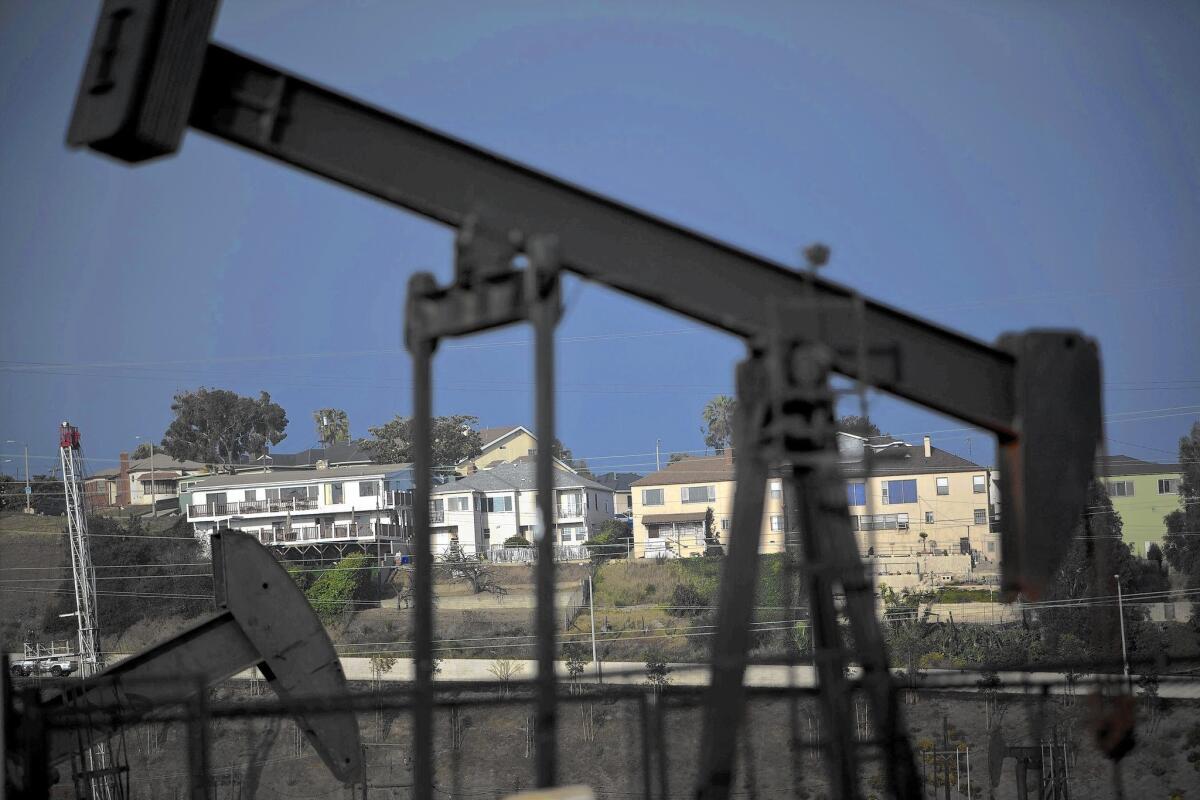More than 5 million in state live near oil or gas well, report says

- Share via
More than 5 million Californians — most of them in Los Angeles and Kern counties — live near an oil or gas well, and expanding drilling in the state could increase their exposure to health risks, according to a report released Wednesday by a national environmental group.
The Natural Resources Defense Council, analyzing state environmental data, identified 5.4 million people who live within a mile of at least one of the state’s 84,000 active or new wells. They are the most likely to be affected by potential air and water pollution caused by oil and gas production if advanced extraction methods such as fracking, acidizing and horizontal drilling expand in California, according to the report.
The Western States Petroleum Assn. dismissed the study’s conclusions, saying that living within a mile of oil production facilities does not pose a health risk.
“We don’t believe that the policy objectives that NRDC is pursuing with this kind of advocacy are in the best interest of California and its consumers,” said Tupper Hull, a spokesman for the oil industry trade group.
In contrast to states like Colorado, North Dakota and Pennsylvania, oil production in California is far below what it was a few decades ago. But in recent years the industry has been drilling new wells and reviving old ones in populated areas.
Production in California rose by 7% last year to 199.6 million barrels, the first increase since the mid-1980s, according to the state Department of Conservation’s Division of Oil, Gas and Geothermal Resources. Officials say that jump was mostly in long-standing fields, not new areas.
Most drilling in California is concentrated in rural Kern County, where the NRDC analysis found nearly 300,000 people live within a mile of one or more of the approximately 57,000 active oil and gas wells. In Los Angeles County, there are about 5,700 active wells, but many more people live near them. The environmental group counted 3.5 million Los Angeles County residents, or about one in three people, living within a mile of an oil or gas well.
A notable hot spot in L.A. County is the Inglewood Oil Field in the Baldwin Hills, where drilling operations sit in close proximity to neighborhoods and “well pads often contain 30 or more wells within a few feet of buildings, roads and parks,” according to the report.
The Natural Resources Defense Council launched the study in response to communities across the state that have expressed concerns over new oil and gas activity nearby.
“We have communities already overburdened, and they could really get the short end of the stick if we allow this technology to continue without the proper evaluation of the health and environment risks,” said Miriam Rotkin-Ellman, senior scientist at the NRDC and lead author of the report.
The potential for petroleum production in California remains uncertain. In May, federal energy officials slashed by 96% estimates of the amount of oil in the state’s vast Monterey Shale formation that can be extracted with existing technology.
The NRDC analysis comes as new information is being disclosed to the public under a law Gov. Jerry Brown signed last year to regulate fracking, the controversial drilling technique of hydraulic fracturing, which injects water, sand and chemicals into the ground at high pressure to break apart rock and free oil and natural gas trapped deep inside the shale.
Among the state’s new requirements under the law are well-permitting rules, notification of neighbors and a study of fracking’s environmental effects. It also governs other well-stimulation techniques such as acidizing, in which acid solutions are injected underground to dissolve rocks and access oil deposits.
Twitter: @tonybarboza







